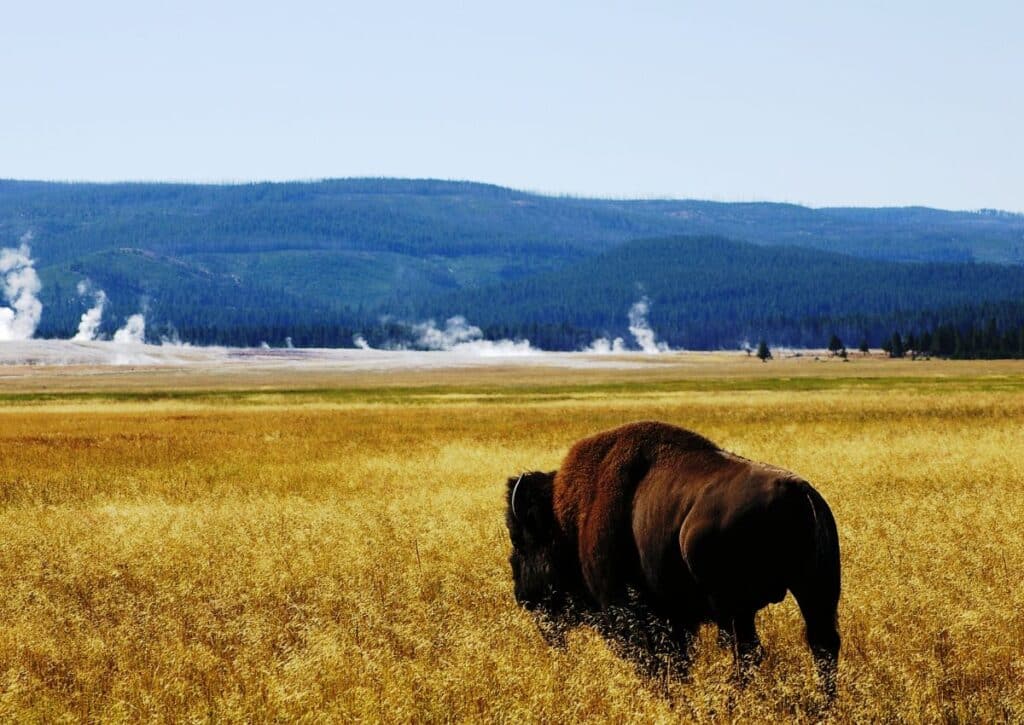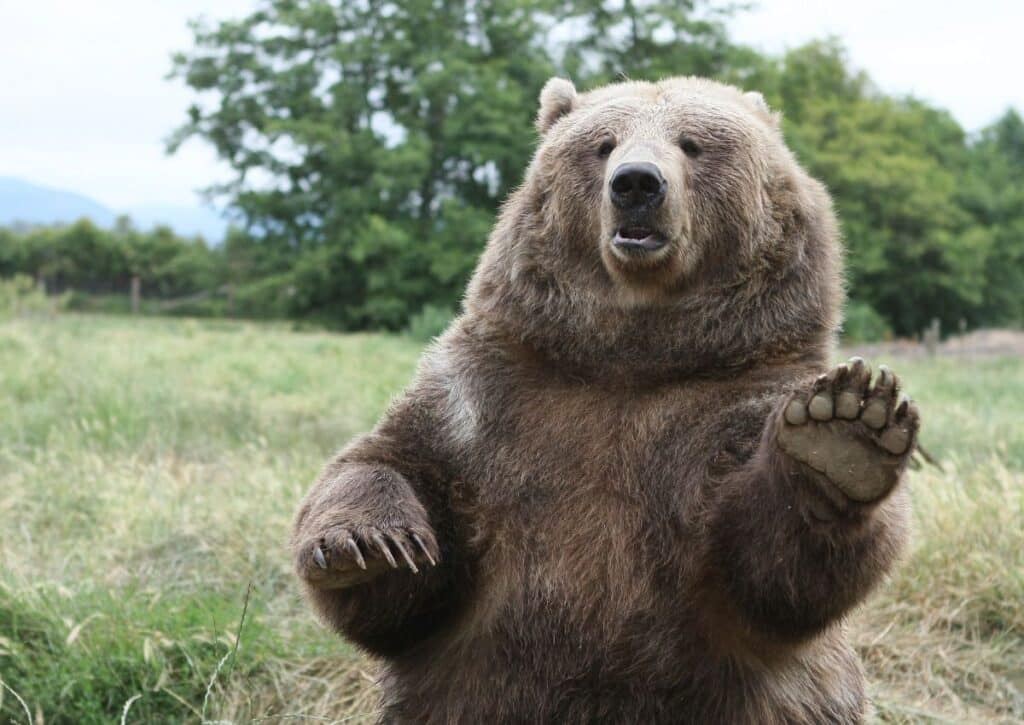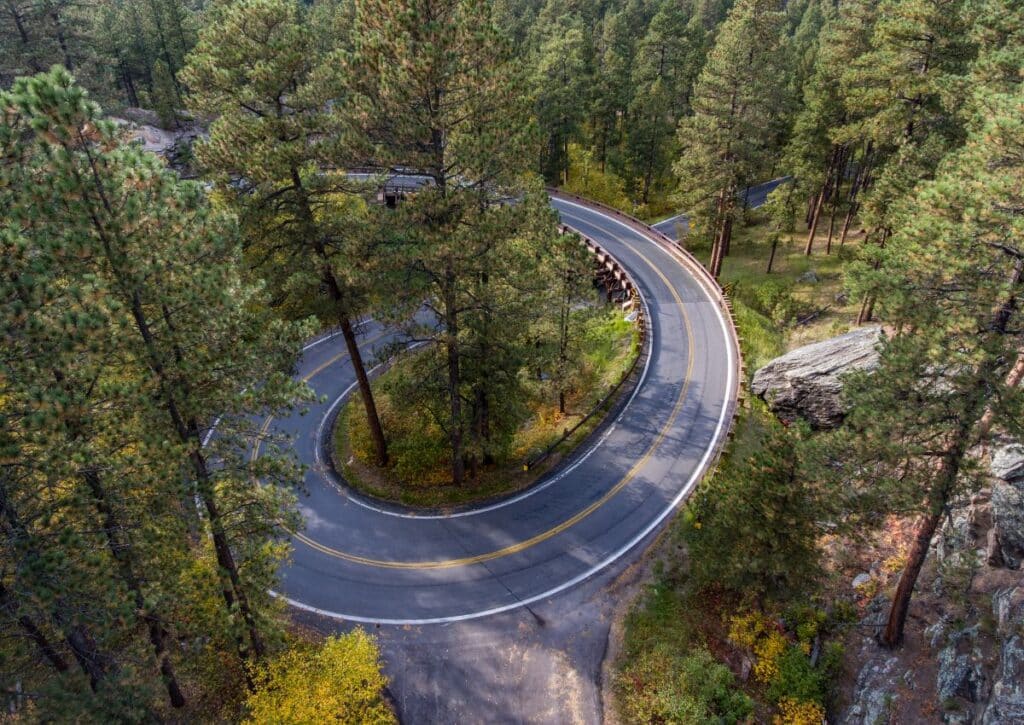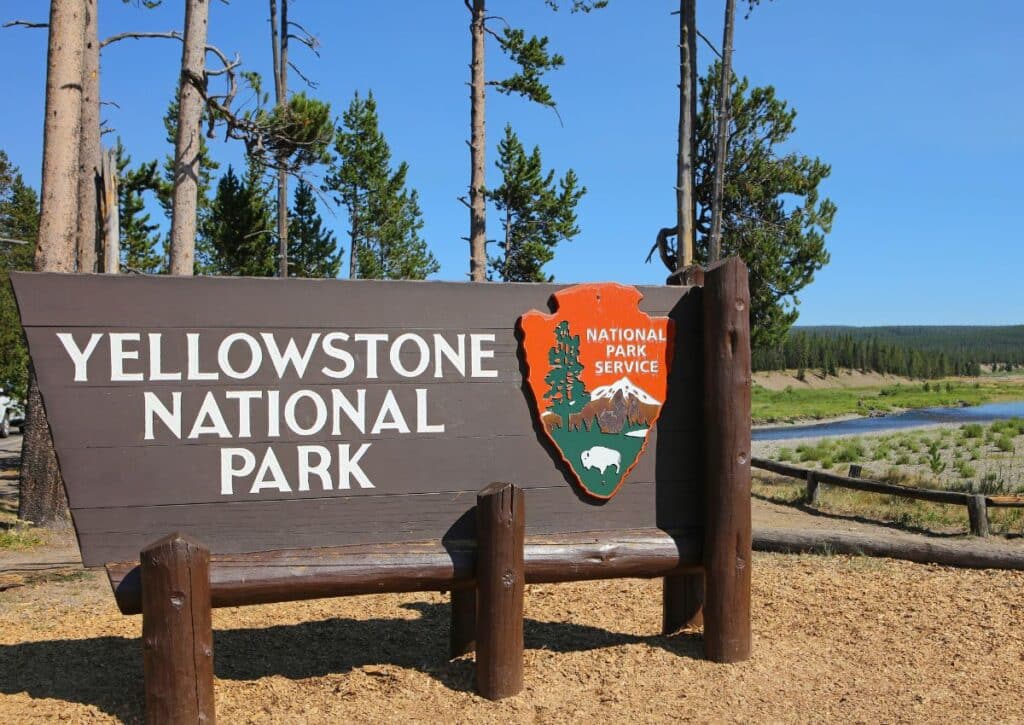Explore the top 9 stops from Lincoln NE to Yellowstone National Park - an essential guide for the ultimate road trip adventure.
Buckle up, fellow travelers, for an unforgettable road trip that stretches from the bustling streets of Lincoln, Nebraska, to the awe-inspiring wilderness of Yellowstone National Park!
Imagine cruising through the heart of America, where each mile brings a new discovery, from the pioneering spirit of the Great Plains to the steaming geysers and majestic wildlife of Yellowstone.
This is no ordinary drive; it’s a week-long odyssey that will take you on scenic routes, through charming small towns, and into the wild, untamed beauty of one of the world’s most famous national parks.
You’ll learn where to catch the best sunrise over a geyser, which trail will give you a panoramic view of the Grand Canyon of the Yellowstone, and where to soak your weary bones in the largest mineral hot spring on the planet.
So grab your map, pack your binoculars, and let’s hit the road. From the perfect campgrounds to the best spots for wildlife watching, we’ve got your itinerary covered.
Get ready for a journey filled with majestic views, frontier history, and natural wonders. Let the adventure begin!
Route Overview: Navigating from Lincoln, NE to Yellowstone National Park
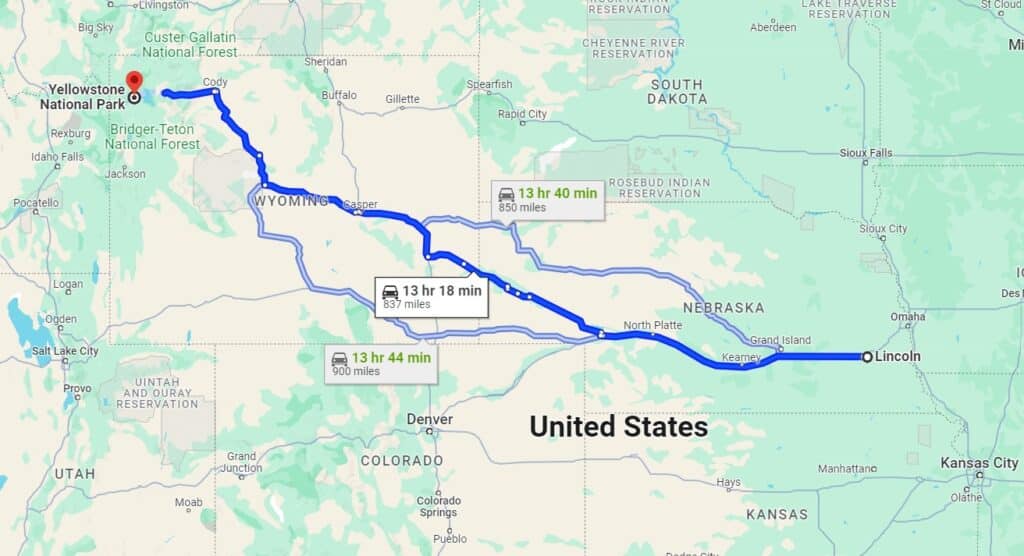
Start Your Engines in Lincoln, NE Your epic road trip kicks off in the heart of Lincoln. After a quick jaunt on N 13th St to E O St, you’ll merge onto I-80 W and set your sights westward.
First Leg: Lincoln to Kearney, NE (about 130 miles) The first stretch of I-80 W will whisk you across the rolling plains of Nebraska.
After roughly 2 hours or 130 miles, you’ll arrive in Kearney. Here, at the heart of America, take a break at The Archway, an impressive structure celebrating pioneer history. Grab a hearty Nebraska breakfast at Tru Café to fuel up for the journey ahead.
Second Leg: Kearney to North Platte, NE (about 100 miles) Continue on I-80 W for another 100 miles (approximately 1.5 hours) to reach North Platte. This city is the gateway to the West and the perfect spot for lunch.
The Lincoln Highway Diner offers a nostalgic dining experience with a menu to match. Enjoy their famous meatloaf or a classic Reuben sandwich before you hit the road again.
Third Leg: North Platte to Scottsbluff, NE (about 175 miles) Your next leg covers 175 miles (around 2.5 hours) to Scottsbluff, a landmark that historically guided pioneers and now promises a panoramic view for modern-day travelers.
Take a detour to visit the Scotts Bluff National Monument, and if you’re feeling peckish, pop into the Emporium Coffeehouse & Café for a quick snack and a delicious cup of coffee.
Fourth Leg: Scottsbluff, NE to Casper, WY (about 150 miles) Crossing into Wyoming, you’ll cover another 150 miles (approximately 2 hours) to Casper.
The landscape shifts from plains to mountain vistas, signaling your arrival in the Cowboy State. Time it right, and you’ll pull into FireRock Steakhouse for dinner just as the sun sets—a perfect backdrop for a Wyoming steak.
Fifth Leg: Casper, WY to Thermopolis, WY (about 130 miles) With a full belly, settle in for the next 130 miles (around 2 hours) of your trip to Thermopolis.
The drive along US-26 W and the Heartland Expy is a visual treat with the Wind River Mountains painting the horizon. Once in Thermopolis, soak your road-weary limbs in the Hot Springs State Park before resting at a local inn.
Final Leg: Thermopolis, WY to Yellowstone National Park (about 160 miles) The last stretch is a scenic 160-mile (about 3 hours) drive through the heart of Wyoming’s rugged landscape on WY-120 W, US-14 W/US-16 W/US-20 W. As you approach Yellowstone, the excitement builds with every mile, culminating in the awe-inspiring beauty of America’s first national park.
Total Distance: Lincoln, NE to Yellowstone National Park Combining all legs, you’re looking at an adventure that spans approximately 837 miles. It’s a journey filled with historical sights, culinary delights, and natural wonders, setting the stage for the ultimate road trip experience.
9 stops between licoln and yellowstone
This list of 9 essential stops combines history, natural beauty, and the spirit of the West. These are places where you can stretch your legs and expand your mind.
Let’s dive into these treasures that pave the way to Yellowstone, ensuring your road trip is as monumental as the destination itself.
Great Platte River Road Archway Monument, Kearney, NE
Straddling the highway like a sentinel of the past, the Great Platte River Road Archway Monument isn’t just a bridge; it’s a timeline of triumph.
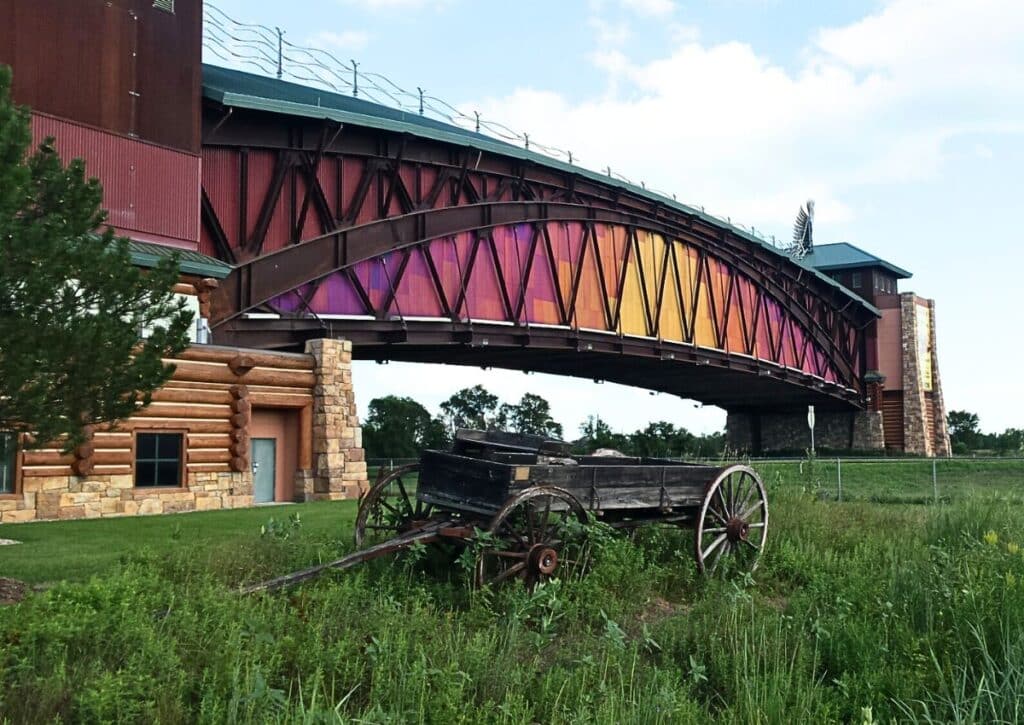
In Kearney, Nebraska, this monument offers a dynamic museum experience that soars above I-80, inviting travelers to delve into the stories of the Oregon Trail, the California Gold Rush, and the advent of the transcontinental railroad.
Inside, you are greeted by immersive exhibits: a covered wagon brimming with the hopes of a family bound for the West, the thunderous sounds of a train chugging toward new frontiers, and the jubilant voices of settlers claiming their destiny.
It’s a tribute to the enduring spirit of the pioneers, innovators, and adventurers who shaped America.
After this enlightening journey through time, you can emerge to enjoy the surrounding trails or relax at the picnic spots, reflecting on the vast distances traveled by those who came before.
Buffalo Bill Ranch State Historical Park, North Platte, NE
Step onto the grounds of the Buffalo Bill Ranch State Historical Park and step back into the Old West. This North Platte gem was the home of William “Buffalo Bill” Cody, the famed showman, and bison hunter whose Wild West shows captivated audiences around the globe.
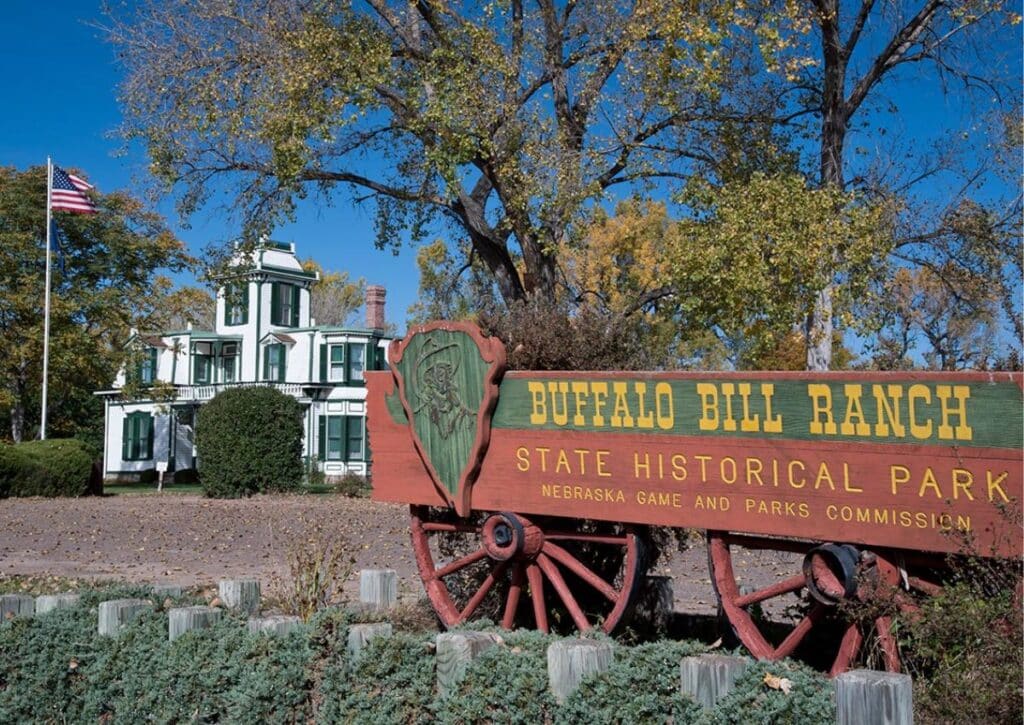
Here, you can tour Cody’s Victorian mansion and barn, which hold a treasure trove of Wild West memorabilia. The park itself invites you to explore the same land that Buffalo Bill once roamed, now tranquil and teeming with wildlife.
Walk along the banks of the Platte River, or simply sit and watch the prairie winds dance through the grasses. It’s more than just a historical site; it’s an opportunity to experience the legend of a man who epitomized the frontier spirit.
Chimney Rock National Historic Site, Bayard, NE
As you approach Chimney Rock, its solitary spire rising out of the Nebraska plains, you’re following in the wagon tracks of countless pioneers who used this natural skyscraper as a beacon across the prairie.
At the Chimney Rock National Historic Site in Bayard, you can marvel at this geological wonder that has stood as a silent witness to westward expansion.
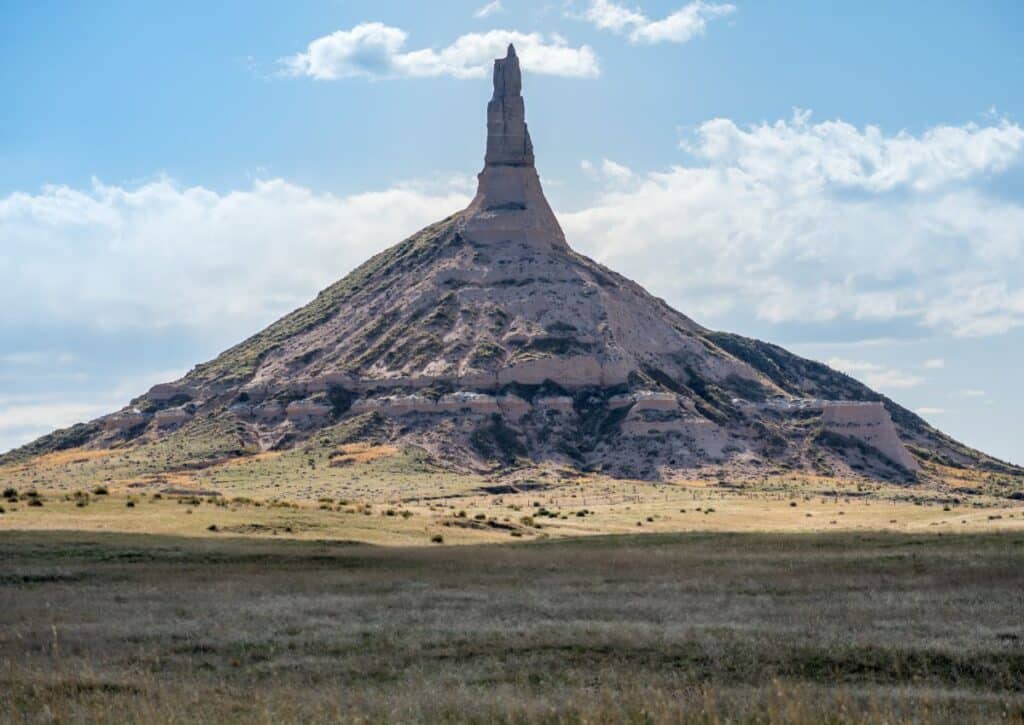
The visitor center offers a wealth of information about the landmark’s geology and history, including its significance to Native American culture and its iconic status on the Oregon Trail.
Take a short hike around the base of the rock to truly appreciate its size and the bravery of those who traveled past it. As the sun sets, casting a golden hue over the rock, it’s easy to feel connected to the history of the land and the legacy of those early travelers.
Scotts Bluff National Monument, Gering, NE
Scotts Bluff National Monument stands as a towering testament to natural beauty and a historical waypoint for those who ventured along the Oregon Trail.
In Gering, Nebraska, this impressive formation rises 800 feet above the North Platte River, offering visitors breathtaking views of the surrounding landscape. Hikers and history buffs alike can traverse the same paths carved by the wheels of pioneer wagons.
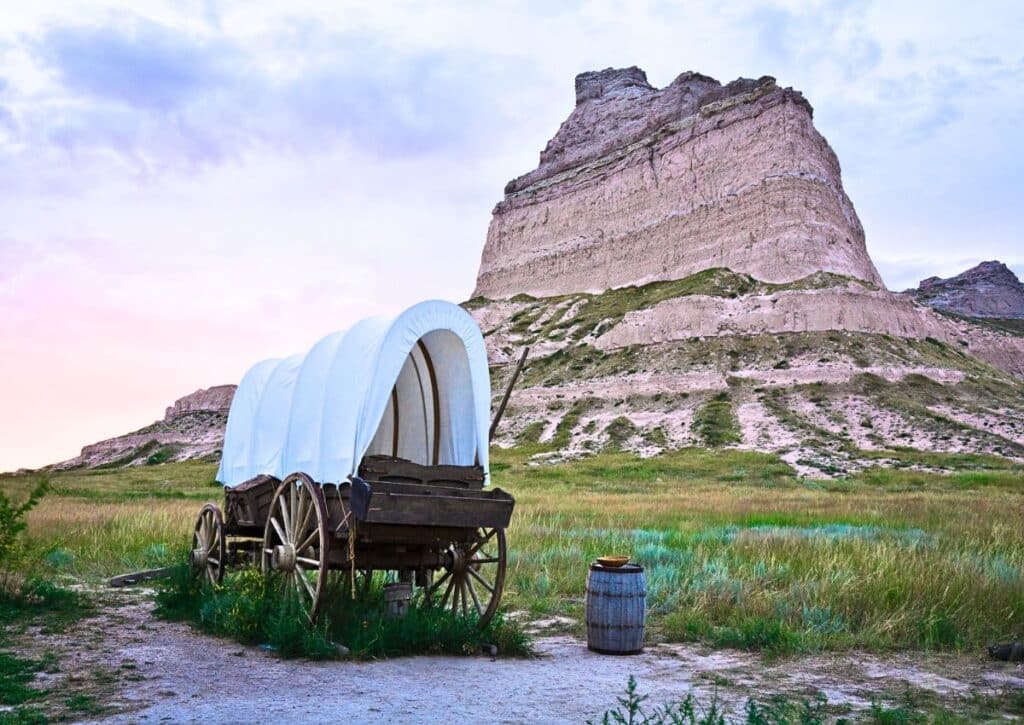
The monument features a museum with exhibits detailing the journey of the early settlers and the rich geological history of the area. The Summit Road, with its tunnels and scenic vistas, provides a less strenuous route to the top for those who prefer to drive.
Whether you’re watching the raptors soar overhead or exploring the Oregon Trail Pathway, Scotts Bluff encapsulates the essence of the American spirit of exploration and the vastness of the West.
Museum of the Fur Trade, Chadron, NE
The Museum of the Fur Trade, located just east of Chadron, stands on the site of James Bordeaux’s Trading Post, which was established for the American Fur Company in 1837.
This museum is dedicated to preserving the rich history of the North American fur trade. Every exhibit, artifact, and fur trade-era replica offers a window into the lives of trappers, traders, and Indigenous peoples who played integral roles in this historical industry.
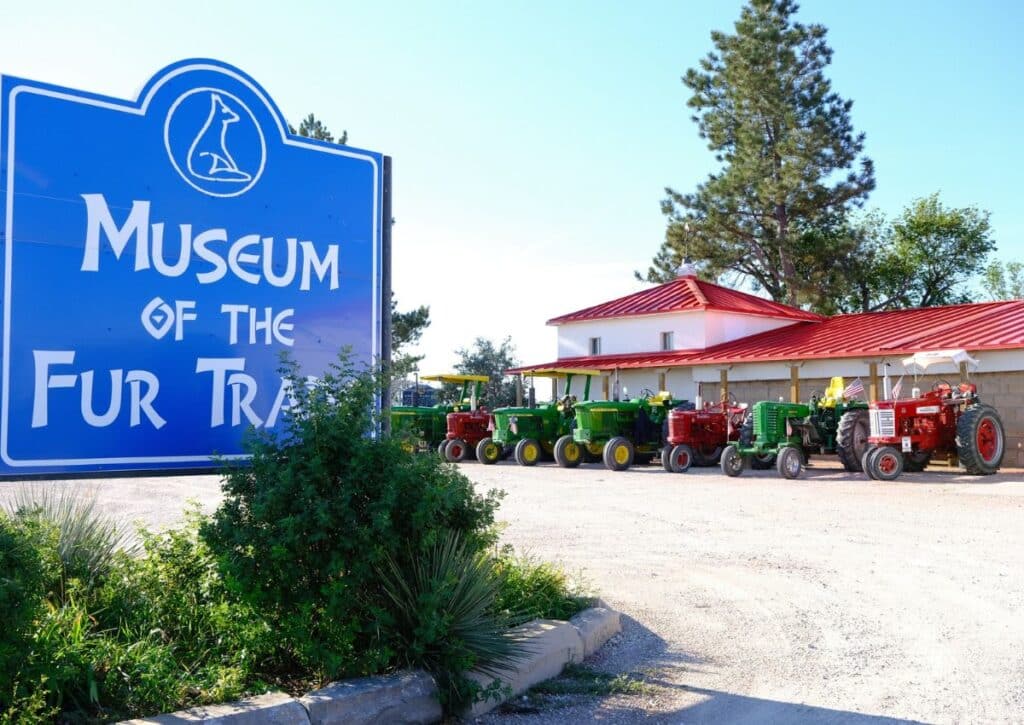
The museum’s collection includes an array of trade goods, firearms, and textiles, all of which tell the story of how the fur trade shaped economic and cultural exchanges between diverse communities.
A walk through the museum’s grounds allows visitors to experience the reconstructed Bordeaux Trading Post and imagine the bustling activity of a bygone era. It’s a place where history comes alive, providing a deeper understanding of the fur trade’s impact on the exploration and settlement of the West.
National Historic Trails Interpretive Center, Casper, WY
In Casper, Wyoming, the National Historic Trails Interpretive Center offers a hands-on journey into the lives of pioneers who traversed the Oregon, California, Mormon, and Pony Express trails.
This interactive museum brings history to life with exhibits that invite you to pull a handcart, experience a simulated river crossing, and gaze out over a prairie landscape that seems almost untouched by time.
The center stands as a tribute to the resilience and determination of the emigrants who shaped the course of American history. Panoramic windows frame the rugged beauty of the landscape they crossed, and interpretive programs provide insights into the challenges they faced.
The National Historic Trails Interpretive Center is not just a museum; it’s an immersive experience that connects visitors to the enduring legacy of the American West’s trailblazers.
Hot Springs State Park, Thermopolis, WY
Hot Springs State Park in Thermopolis is a haven for relaxation and natural wonder. It’s home to the world’s largest mineral hot spring, where travelers can soak in therapeutic waters just as Native Americans and early settlers did centuries ago.
The park’s bathhouse offers a comfortable setting for a rejuvenating dip, free of charge. Beyond the hot springs, you can walk along the boardwalks to see the colorful terraces formed by mineral deposits, or cross the swinging bridge over the Bighorn River for a bit of excitement and excellent river views.
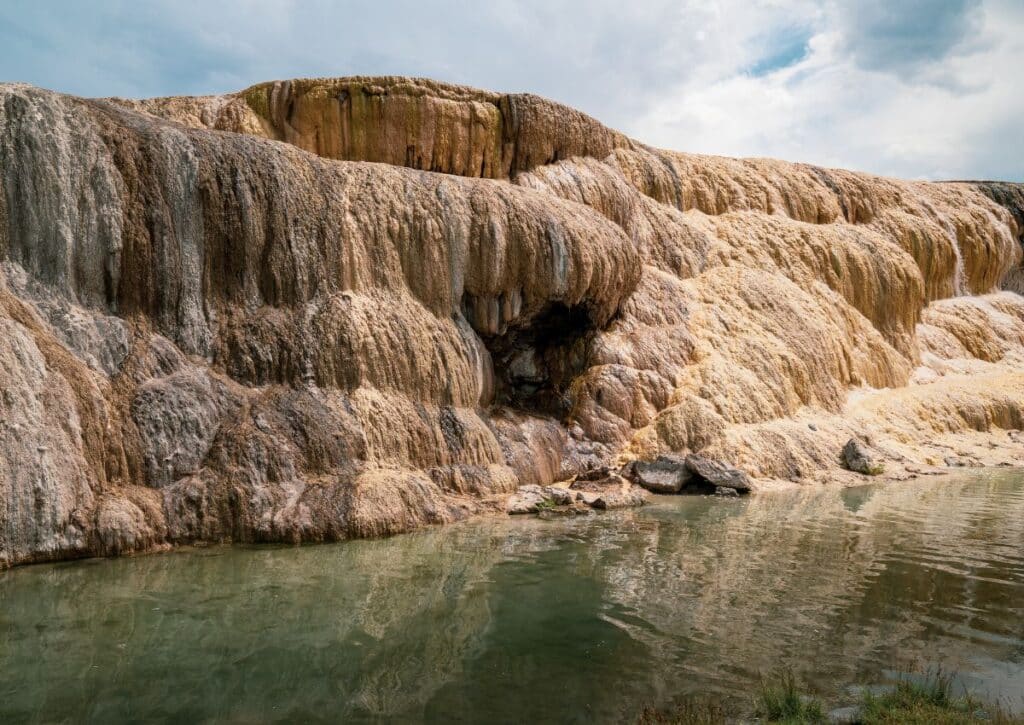
Wildlife is abundant here—bison roam the hills and birds fill the skies, making it an ideal spot for nature lovers. The park’s peaceful atmosphere is a welcome respite from the road, providing a serene interlude before the grandeur of Yellowstone.
Cody, WY
Cody, Wyoming, founded by Buffalo Bill Cody himself, is a gateway to the West and a hub of cowboy culture. The town is a destination in its own right with the Buffalo Bill Center of the West, a massive complex of five museums ranging from natural history to Western art and firearms.
Cody keeps the spirit of the Wild West alive with nightly rodeos in the summer and a variety of Western-themed shops and restaurants.
The Cody Firearms Experience offers a hands-on opportunity to learn about and even fire replicas of historic guns under expert supervision.
For outdoor enthusiasts, the nearby Shoshone River provides excellent fishing, white-water rafting, and picturesque hiking trails. Cody is more than a stop; it’s a deep dive into the essence of the American frontier.
Beartooth Highway, MT
The Beartooth Highway is a spectacular mountain road that’s often described as one of the most beautiful drives in America.
Connecting Red Lodge, Montana, to the northeastern entrance of Yellowstone, this All-American Road ascends to a breathtaking 10,947 feet.
With dozens of switchbacks, vast alpine plateaus, and stunning vistas, it’s a drive that outdoor enthusiasts dream of. Along the route, there are numerous pull-offs for photographing the rugged peaks, glacial lakes, and expansive meadows.
Adventurous travelers can take advantage of the numerous hiking trails that lead into the surrounding wilderness, or simply enjoy a picnic with panoramic views.
The highway is typically open from late May to mid-October, weather permitting, offering a memorable entrance or exit to Yellowstone National Park.
Our Recommended 7-Day Itinerary from Lincoln, NE to Yellowstone National Park
Day 1: Lincoln to Kearney, NE
Rise and shine early in Lincoln for the first leg of your epic road trip. The journey to Kearney covers roughly 130 miles, a perfect morning drive with the sun ascending alongside you.
Upon arrival in Kearney, stretch those legs and take a leap back in time at the Great Platte River Road Archway Monument. This isn’t just a pit stop; it’s your first encounter with the pioneer spirit that paved the way to the West.
After you’ve soaked in the history, it’s time to indulge in some local flavors. Grab lunch at one of Kearney’s welcoming diners. Refueled and ready, you’ll hit the road again, venturing another 100 miles to your day’s final destination: North Platte.
Your arrival in North Platte marks about 230 miles of American landscape under your belt. Here, you can relax and reminisce about the day’s adventures. Check into a cozy local hotel and unwind. You’ve earned a good night’s sleep; tomorrow promises even more discoveries on the road to Yellowstone.
Day 2: North Platte, NE to Yellowstone National Park
With the first light of day as your guide, leave North Platte behind as you head northwest, bound for the wilds of Yellowstone National Park.
Today’s journey is a grand traverse of about 450 miles, leading you from the open plains of Nebraska into the rugged majesty of the Wyoming mountains.
The route promises views of a landscape that’s as untamed as it is striking, providing a visual feast as you draw closer to America’s first national park.
As the afternoon sun dips toward the horizon, bypass the charm of Cody and continue straight to the heart of Yellowstone. Enter through the park’s East Entrance and make your way to your pre-booked campsite within the park boundaries.
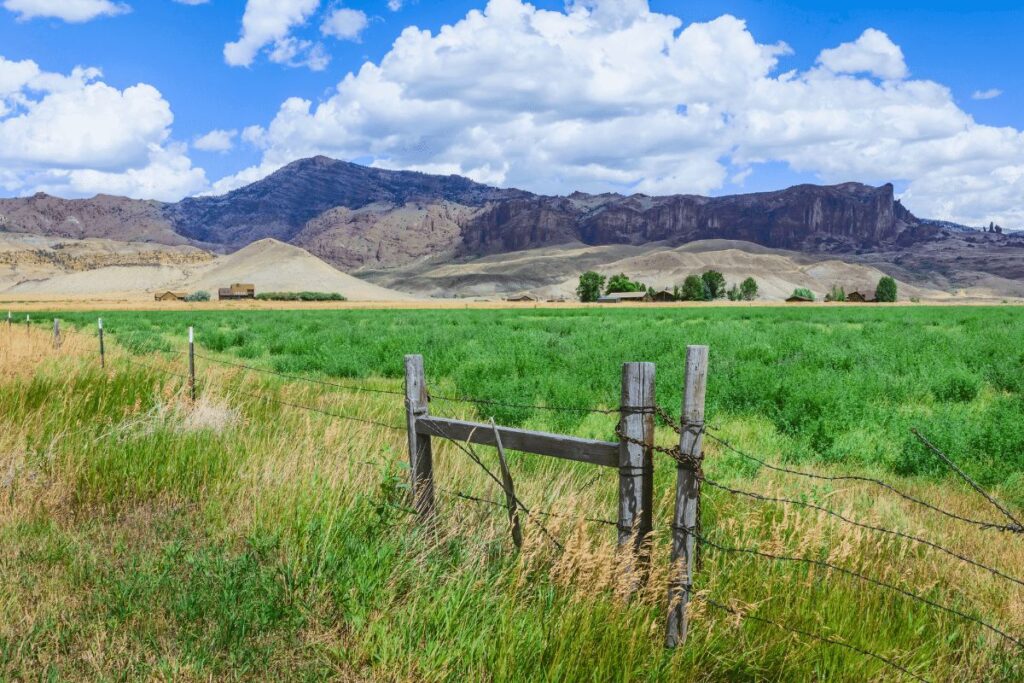
Sites like the Bridge Bay, Grant Village, or Madison Campgrounds offer a range of amenities and put you in prime position to start exploring the park right away.
Settle into your campsite nestled among the pines or by the glistening Yellowstone Lake. The evening is yours to relax and immerse yourself in the natural beauty of your surroundings. As night falls, the star-studded sky creates a perfect canopy overhead, setting the stage for the wilderness explorations that await you.
Day 3: Discovering Yellowstone’s Geothermal Wonders and Grand Canyons
Awake to the tranquil surroundings of Yellowstone Lake. As the sun crests the horizon, take in the calm beauty of the largest high-elevation lake in North America. It’s the perfect start to a day filled with discovery.
After breakfast, head over to the Mud Volcano area, just a short drive from most campgrounds around the lake. Here, you’ll encounter bubbling mud pots and fumaroles that showcase the park’s volcanic activity. The area is easily accessible via a short loop of about 0.6 miles, making for an easy and intriguing morning walk.
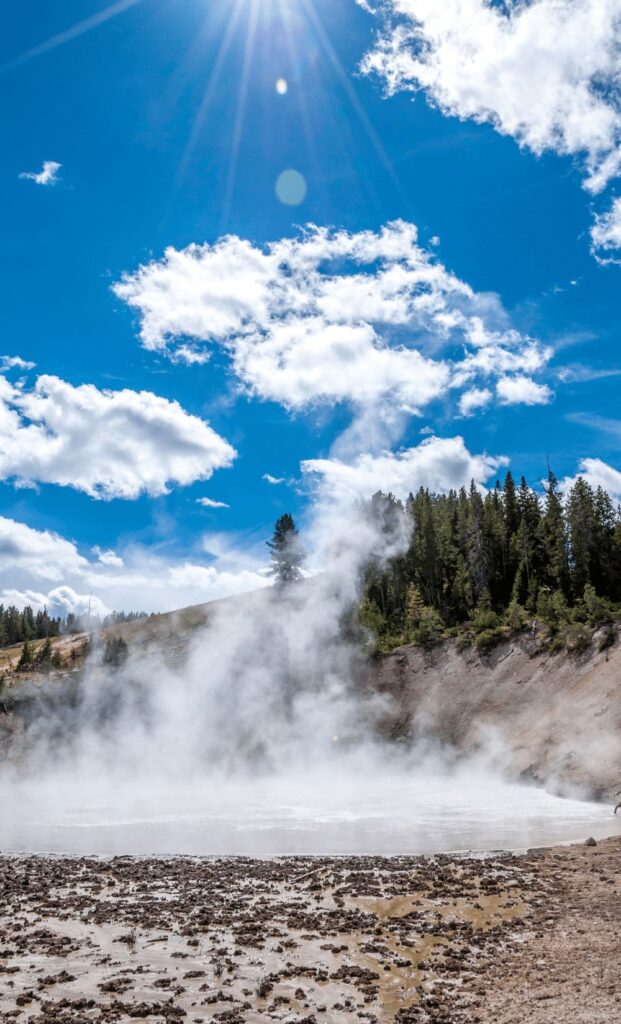
As midday approaches, gear up for the highlight of the day—the Grand Canyon of the Yellowstone. Start at Artist Point, a must-see lookout that provides a postcard-perfect view of the Lower Falls, Yellowstone’s highest waterfall at 308 feet. For a more immersive experience, take on the South Rim Trail, a moderate 1.7-mile one-way hike that offers stunning views of the canyon and the falls.
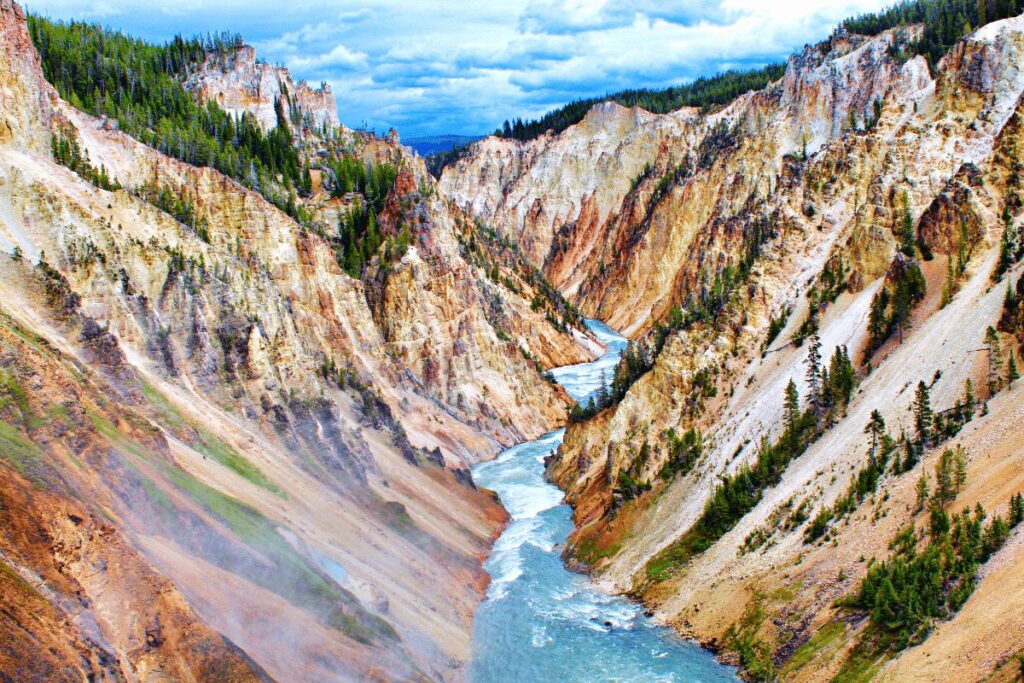
For those seeking a closer view of the Lower Falls, consider the descent down Uncle Tom’s Trail. This strenuous trail includes over 300 steps leading down to the base of the falls, but the up-close view of the thundering water is well worth the effort.
Return to your campsite by late afternoon to relax and reflect on the day’s adventures. The evening is yours to unwind under the expansive Yellowstone sky, recounting your experiences or simply enjoying the quiet beauty of nature’s grandeur.
Day 4: Wildlife Encounters and Geysers Galore
Prepare for a day filled with some of Yellowstone’s most iconic wildlife and geothermal features. Before the park stirs, set off for a sunrise visit to Hayden Valley.
Renowned for its wildlife, including bison, elk, and sometimes even bears or wolves, the valley is a prime spot for animal sightings. Bring your binoculars and enjoy the morning chorus of nature in this vast, open landscape.
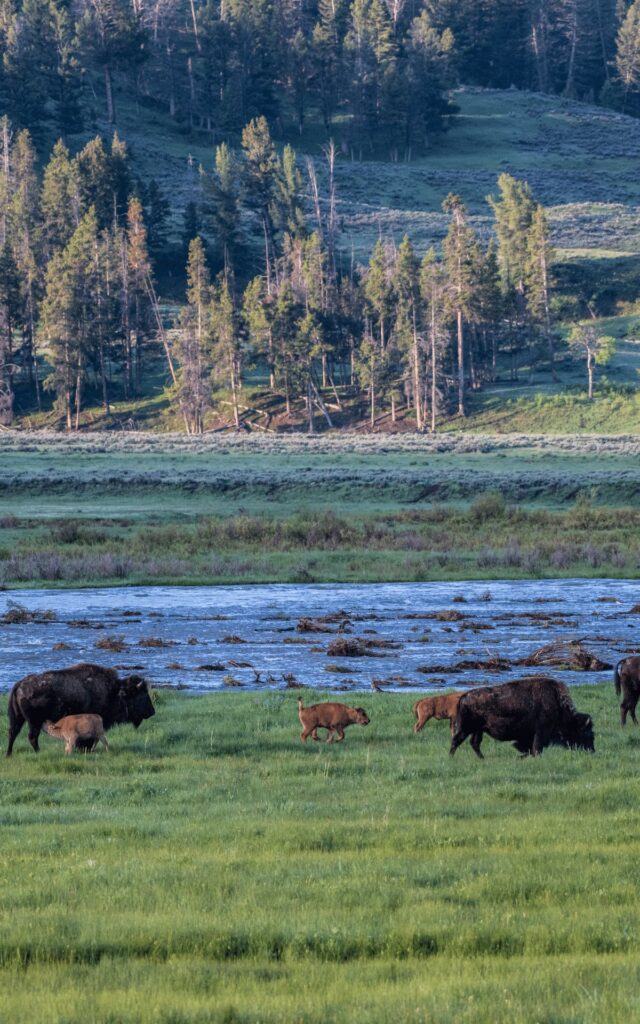
After breakfast, make your way to the world-famous Old Faithful Geyser. Plan to arrive at least 30 minutes early to secure a good viewing spot for this predictable wonder, which erupts every 90 minutes or so. The Old Faithful area is also home to a variety of shorter boardwalk loops, like the 0.8-mile Upper Geyser Basin loop, that lead you past multiple geysers and hot springs.
In the afternoon, switch up your scenery and drive to the Norris Geyser Basin, the park’s hottest and most dynamic thermal area.
Here, you can explore the 1.5-mile Porcelain Basin loop or the 2-mile Back Basin loop, where you’ll see an array of hot springs, steam vents, and geysers, including the world’s tallest active geyser, Steamboat Geyser.
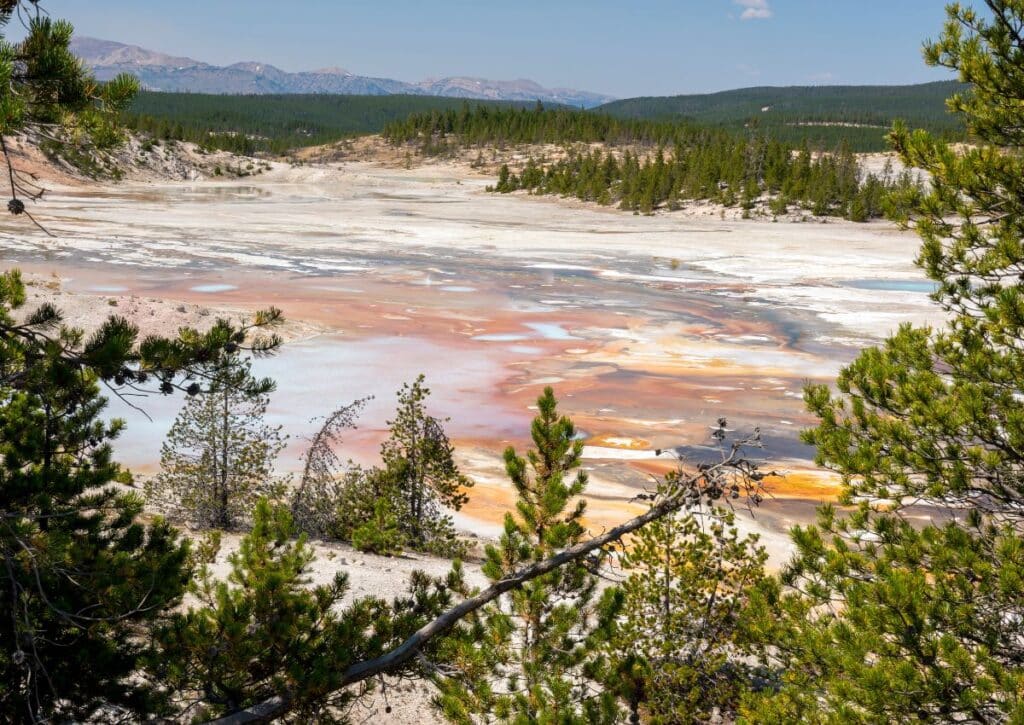
End your day by setting up camp at the Norris Campground, giving you a different angle of Yellowstone to enjoy. The evening is yours to relax and reminisce about the day’s natural spectacles, all within the unique and diverse landscapes of Yellowstone National Park.
Day 5: A Journey Through Yellowstone’s Majestic North
On your fifth day, rise with the dawn chorus at Norris Campground and prepare for a day exploring Yellowstone’s northern treasures. After a hearty breakfast, pack up and start your day at the Mammoth Hot Springs.
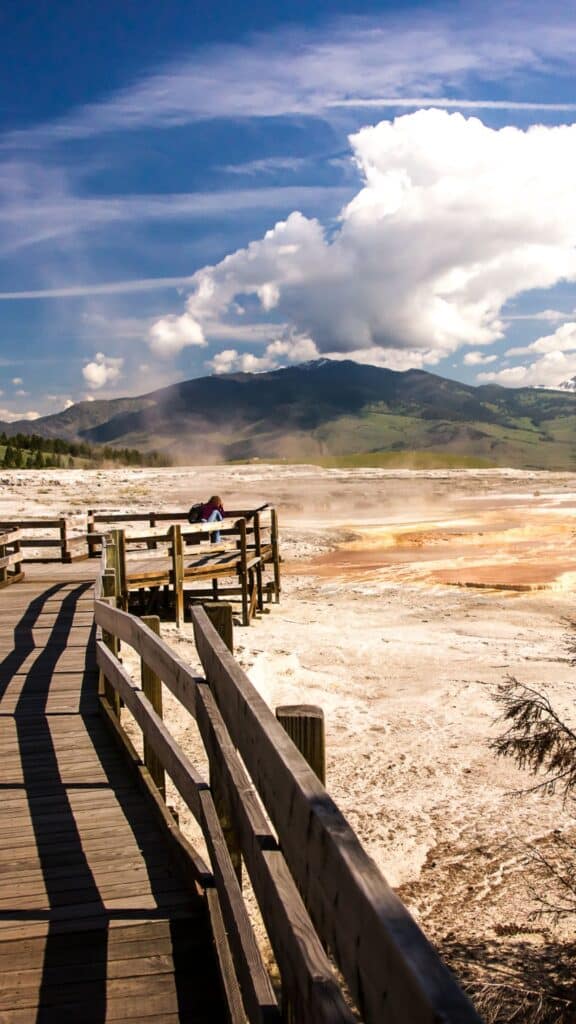
These terraced hot springs are a sight to behold with their steaming water and chalky white travertine formations. Walk the boardwalks that weave around the area — the Lower Terrace loop is an easy 1.75 miles and gives you a comprehensive view of these unique formations.
Midday, make your way toward the Lamar Valley — often referred to as America’s Serengeti for its vast landscapes and abundant wildlife. Bring your binoculars and a sense of patience; Lamar Valley is one of the best places in the park to spot wolves, as well as herds of bison and pronghorn antelope.
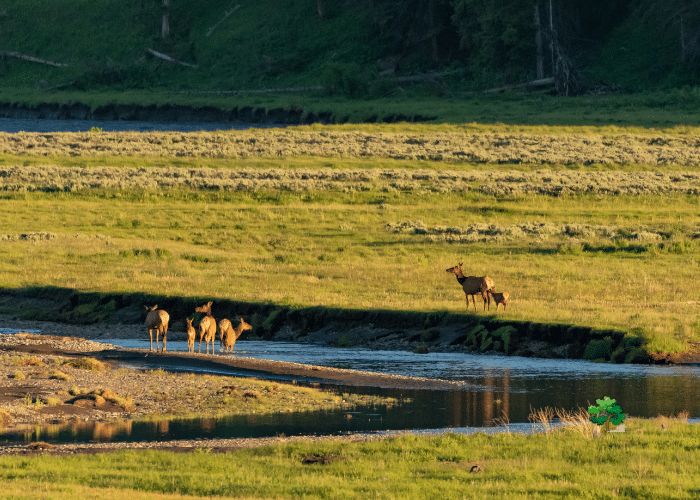
There are numerous pullouts along the valley road where you can park and watch the wildlife; it’s worth spending a couple of hours here for the chance to observe these animals in their natural habitat.
In the afternoon, head to the Tower Fall area to see the famous 132-foot waterfall that plunges into the Yellowstone River. Nearby, you can take a short hike to view the basalt columns of the Tower Falls Overlook, or for a more challenging trek, embark on the 2.5-mile round trip hike to Mount Washburn for spectacular panoramic views.
For your final night, choose a campground in the Tower-Roosevelt area to experience the rugged wilderness that defines Yellowstone’s northern region.
Spend your evening enjoying the alpenglow on the mountains and reflecting on the ancient forces that shaped this diverse landscape.
Day 6: Farewell to Yellowstone and a Soak in Thermopolis
As you wake up in the Tower-Roosevelt area, take a moment to breathe in the crisp morning air and enjoy the peaceful Yellowstone surroundings for one last time.
Today you’ll bid farewell to the park, but not without taking with you a collection of memories from this wild heartland.
After packing up camp, exit Yellowstone through the East Entrance. The drive out is another opportunity to appreciate the park’s natural beauty.
Stop at any remaining viewpoints or trails you might have missed or simply want to revisit one last time. As you leave the park, keep an eye out for any last-minute wildlife sightings along the way.
Your journey will continue to Thermopolis, WY, home to the world’s largest mineral hot spring located in Hot Springs State Park. After the adventurous days in Yellowstone, the hot springs will offer a soothing retreat.
The drive from Yellowstone’s East Entrance to Thermopolis is about 150 miles, taking roughly 3 hours, so you’ll arrive with plenty of afternoon left to enjoy the springs.
Choose from one of the public bathhouses or, if you prefer something more secluded, check into one of the local inns or resorts that offer private soaking pools.
Spend your evening unwinding in the therapeutic mineral waters, reflecting on the vast wilderness you’ve traversed, and letting the warmth of the springs ease the bittersweet feeling of your Yellowstone adventure coming to an end.
Stay overnight in Thermopolis, allowing for a restful break before the final leg of your journey back to Lincoln.
Day 7: Thermopolis to Lincoln – The Homeward Trail
After a restful night in Thermopolis, Wyoming, surrounded by the comfort of natural hot springs, it’s time to start the last day of your journey.
Take the morning to slowly depart from the warmth of Thermopolis. Perhaps enjoy one last soak in the hot springs or a leisurely breakfast at a local cafe as you ready yourself for the drive back to Lincoln, Nebraska.
The road home is a chance to reflect on the experiences of the past week. The landscapes that pass by your window have become familiar, yet they hold a new resonance after the days spent exploring Yellowstone.
The drive from Thermopolis back to Lincoln covers approximately 600 miles and will take most of the day, so be sure to leave with enough time to travel safely and comfortably.
As you cross the state line back into Nebraska, the setting sun might just accompany you, casting a golden glow over the plains. It’s a fitting end to a trip that has been as much about the journey as the destination.
Finally, as you arrive back in Lincoln, the sense of adventure doesn’t have to end. Unpack your memories along with your gear, and know that the spirit of the West, the majesty of Yellowstone, and the tranquility of Thermopolis hot springs are experiences that will stay with you long after this road trip concludes. Welcome home.
Common Questions When Planning the Drive From Lincoln to Yellowstone National Park
When planning a drive from Lincoln, NE to Yellowstone National Park, several common questions might arise as you prepare for the journey. Here’s a concise overview to address these queries:
How long is the drive from Lincoln to Yellowstone? The drive spans approximately 837 miles and takes around 13 hours and 21 minutes without stops.
What are the best places to stop along the way? Some of the best stops include Kearney for the Archway Monument, North Platte for the Buffalo Bill Ranch, and Cody, WY for a taste of the Old West before entering Yellowstone.
Are there campgrounds available in Yellowstone? Yes, Yellowstone has several campgrounds with varying amenities, but it’s essential to book in advance due to high demand.
What activities can I do in Yellowstone? Yellowstone offers a plethora of activities, including wildlife viewing in Hayden Valley, geyser watching at Old Faithful, and hiking trails like the South Rim Trail of the Grand Canyon of Yellowstone.
Do I need a reservation to enter the park? As of the last update, Yellowstone does not require reservations to enter, but some services and campgrounds do require advance booking.
Is there a best time of year to visit Yellowstone? The best time to visit is from late spring to early fall when most park facilities are open and the weather is conducive to exploring.

